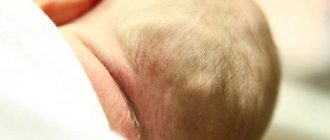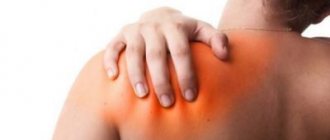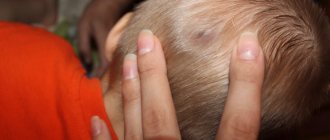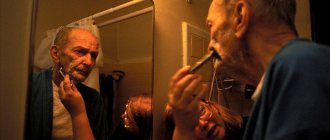Reasons for the appearance of a lump
Lipoma on the forehead - before and after surgery
A bump on the forehead does not appear without a reason - there is always an obvious or hidden negative factor that contributes to its occurrence:
- consequence of a blow, bruise, injury;
- allergic reaction due to an insect bite;
- neoplasm of a malignant and benign nature: lipoma, wart, cyst, fibroma, osteoma, etc.;
- purulent inflammation: boil, abscess, enlarged lymph node.
Bumps of traumatic origin appear on the head and forehead due to tissue swelling. They may change color (become blue, red) and become very painful when pressed. If the blow was noticeable enough, you need to see a neurologist to rule out a concussion and brain contusion.
When bitten by insects (wasp, bee, gadfly, etc.), a person may complain of pain at the site of skin damage, which gradually decreases. The lump develops in the form of an allergy to insect venom.
If there were no obvious impacts (trauma, bite), special attention must be paid to health. The presence of a painful, swollen lump, growth, or bulge that changes the skin tone may indicate an inflammatory process.
Lump on the temple - reasons for formation at this place
A lump on the temple is an uncommon symptom. But it may indicate a disorder or even a serious illness. Therefore, in case of swelling and bumps in the temporal part of the head, you need to consult a specialist.
Why do temples swell?
Most often, swelling of the temple and lumps in the temporal part are provoked by local pathology. Systemic disease is rarely present in etiology.
Damage to the temporomandibular joint
In case of diseases of the jaw joint (for example, arthritis of the temporomandibular joints), a person experiences pain below the temples on the cheekbones, in front of the auricle; sometimes pain and swelling (bumps) appear on top of the ear, on the temples. The attacks are accompanied by a limited ability to open the mouth, sometimes with a lateral deviation, and it can be difficult to chew solid food.
Temporal arteritis
If the temples are swollen, a lump appears, the vein may have temporal arteritis - an inflammatory vasculopathy characteristic of older people.
Neurological symptoms:
- headache;
- memory impairment;
- dementia.
Eye signs:
- sudden and irreversible, usually significant decrease in visual function.
Systemic symptoms:
- fatigue;
- sleep disturbance;
- night sweats;
- weight loss;
- pain in the jaw and temporal region while eating (the jaw does not deviate to the side);
- muscle pain.
Important! When a lump appears on the temples, timely diagnosis is important for starting treatment; delayed identification of the problem is fraught with blindness.
What measures to take
If there is redness, swelling, or bumps on the temples, you should consult a specialist. This is a symptom of a number of diseases that can lead to serious consequences.
Which specialist treats swelling of the temples
Treatment or its individual dosage for swelling and bumps on the temples is strictly individual. Long-term monitoring for adverse complications is necessary. The cooperation of a therapist, immunologist, rheumatologist, ENT specialist, and neurologist is required.
Treatment of temporal arteritis
Today, the fundamental stone of treatment for lumps on the temples with temporal arteritis is treatment with corticosteroids.
It should be started without delay, consisting of relatively high doses of steroids, preferably during hospitalization with intravenous methylprednisolone.
At the same time, antiulcer drugs (H2 receptor antagonists, proton pump inhibitors) are administered to prevent steroid-induced peptic ulcers, and potassium chloride is administered to supplement potassium in cases of increased urinary loss.
Causes of a bump on the head
The reasons why temples swell and bumps appear on the head are varied. They are represented by both relatively trivial factors and serious illnesses. Therefore, it is important to consult a doctor in a timely manner, identify the cause and eliminate it.
Lump on the head - what could it be?
Insect bites and neoplasms in fatty or bone tissue may be responsible for the appearance of lumps, bumps, and swelling.
Injury
The right or left temple may be affected by a bruise, most often occurring when exposed to a blunt blow with a large area. With this problem, reversible destruction of neuronal membranes can occur.
This functional state with immediate onset has no morphological background and is accompanied by vasomotor and autonomic symptoms. Soreness in the eye appears, pain in the temple, and swelling occurs.
Headaches and nausea are also common.
Allergy
An allergy is an exaggerated, inappropriate response of the body's immune system to substances that a person commonly encounters in the environment. These substances - allergens - include mites, pollen, animal hair, and food ingredients.
Symptoms:
- swelling of the nasal mucosa (allergic rhinitis);
- various types of eczema, rashes;
- redness, itching, swelling of the eyes (allergic conjunctivitis);
- narrowing of the trachea, bronchitis, shortness of breath, sometimes an asthmatic attack.
If your temples are swollen on both sides, accompanied by these symptoms, consult an allergist.
Lipoma
A fatty tumor or lipoma is actually a tumor, but a benign one. Lipomas grow very slowly, consist of fat cells, and look like a ball under the skin. Wen can occur anywhere in the body where there is fat, for example, near internal organs, and can be multiple.
Most often, fat deposits come from the layer of subcutaneous adipose tissue, therefore, they can form on the temples in the form of a lump. Lipomas are soft, elastic, mostly non-painful. The wen hurts when you press on a nerve or if you have an angiolipoma (a lipoma richly supplied with blood vessels).
Osteoma
This is a benign tumor growing from bone tissue. The neoplasm is usually diagnosed in children and adolescents, accounts for about 10% of all bone tumors, and can occur without clinical manifestations or appear as a lump, including on the temples. Only in certain localizations does osteoma cause serious disorders.
Atheroma
This is a skin cyst that occurs due to blocked sebaceous glands and overproduction of sebum.
Atheroma is an enlarged sebaceous gland. Its content has a whitish color (it may differ during infection or other processes).
On the side facing the surface of the skin, there is often a small filled hole - in most cases, the cause of atheroma.
Depending on the size of the atheroma, the skin deforms and becomes thinner in different ways. Atheroma in the form of a lump on the temples is one of the most noticeable.
Important! On the cheek, gumboil looks like atheroma, but it is painful.
Furuncle
A furuncle is an abscessed purulent inflammation of a hair follicle or skin glands, causing epithelial necrosis that spreads to the surrounding area.
The area of the boil is red, painful, hot, and swollen. As it develops, pus forms in the middle, forming a mucous crust that usually bursts.
Fibroma
This is a benign tumor formed on the body from connective tissue. It is harmless and is mainly a cosmetic defect.
Source: https://bolitgolova.guru/golovnaya-bol/shishka-na-viske
Clinical picture
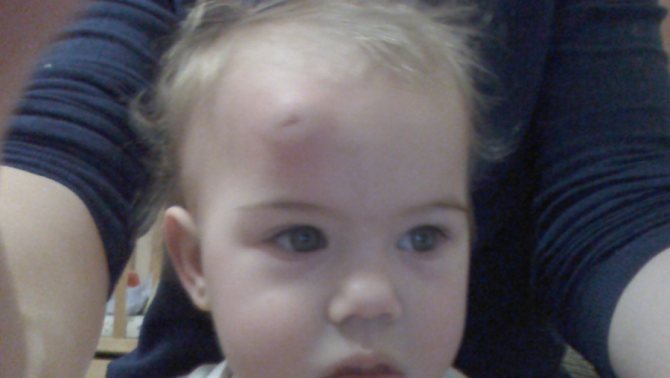
If a child starts vomiting after being hit, there may be a concussion.
If, after a blow to the head, an adult or child experiences:
- headache;
- darkening of the eyes;
- disorientation in space;
- nausea, dizziness;
- amnesia.
This indicates a concussion. The condition is classified as a mild head injury and often leaves no consequences. You should immediately seek medical help if, after a blow and a lump appears on your forehead, you experience:
- confusion of thoughts;
- convulsions;
- numbness of the limbs;
- lethargy, drowsiness;
- repeated bouts of vomiting;
- motor and speech disorders;
- stiffness of the neck muscles.
A growth on the skin after a bite can be identified by the presence of a red dot in the middle, as if from a syringe injection. It may not change color or may turn red, itch constantly, or increase in size.
Local inflammations have symptoms of boils (large pimples filled with purulent contents). If the pathological process is systemic in nature, enlarged lymph nodes appear in the form of oval swellings in the area of the back of the head. They are dense on palpation, painful, but have no signs of inflammation.
Lumps under the skin causes, methods of diagnosis and treatment
Lumps under the skin are painful or painless formations that appear in different places - on the limbs, in the groin area, on the face, head, back, neck or chest.
They can appear after an injury, during a metabolic disorder or an exacerbation of a disease.
If you detect lumps under the skin, you should definitely consult a doctor to rule out malignant tumors or, if they are present, to begin the correct treatment.
Symptoms of lumps under the skin
Formations under the skin are accompanied by the following symptoms:
Causes
The causes of lumps under the skin include:
- skin fibroma;
- hemangioma;
- infectious diseases;
- wart;
- birthmark;
- foreign bodies;
- increased work of the sebaceous glands.
Types of seals
Doctors distinguish many types of subcutaneous seals. The most common are:
- lipomas;
- hygromas;
- atheromas;
- enlarged lymph nodes;
- millet;
- abscess;
- hernia;
- malignant neoplasms.
Lipomas
Lipomas or lipomas are benign tumors that arise in the fatty tissue of the skin. There are single and multiple.
They appear in people with liver pathologies, pancreatic diseases, diabetes mellitus and alcoholism.
Lipomas can also be influenced by genetic predisposition, diseases of the urinary system and hormonal changes in the body.
Wen is more often diagnosed in women aged 30 to 45 years. They develop painless, hard balls under the skin. Seals tend to grow.
Hygromas
Hygroma or synovial cyst is a benign tumor filled with serous-mucosal or serous-fibrous fluid.
It can develop after unsuccessful surgery on the hand, due to injury or hereditary predisposition. In women, synovial cysts occur 3 times more often than in men.
Hygromas can cause acute pain or be accompanied by constant dull pain. In 40% of cases they do not cause symptoms.
Atheromas
Atheroma is a benign round tumor consisting of a capsule filled with a thick yellow or white liquid with an unpleasant odor. They are diagnosed in 5-10% of people. There are 2 types of atheromas - true and false.
True atheromas appear from microparticles of the epidermis with a hereditary predisposition. False formations develop in the area of blockage of the sebaceous duct, leading to the accumulation of secretions.
Atheromas can occur in people with impaired metabolism, unfavorable environmental conditions and hormonal changes.
Enlarged lymph nodes
Swollen lymph nodes can be a symptom of infection. Near an enlarged lymph node, you can sometimes notice a scratch or deep wound. If after treatment the lump does not resolve and causes pain, you should immediately visit a doctor.
Prosyanka
A disease characterized by the formation of small white lumps. They can be single or grouped. Millet occurs when sebum is retained and improper skin care. Whiteheads are often found on the facial skin of newborns. Over time, they go away on their own without causing complications.
Abscess
It is characterized by painful compaction under the skin, redness and local fever. The causes of an abscess can be mechanical damage, impact and injection. You should immediately consult a doctor to avoid negative consequences.
Hernia
Swelling develops in the thighs, groin, navel and other places. It can be caused by chronic lung pathologies, heavy lifting, pregnancy and childbirth, constipation and spinal injuries. A hernia is often accompanied by pain, nausea and vomiting.
Malignant tumors
Their peculiarity is that for a long time they are asymptomatic. Noticeable manifestations occur in the later stages, when the formations reach significant sizes. In such cases, only surgical intervention is required.
To identify a lipoma, the doctor conducts a survey of the patient and a visual examination with palpation of the affected area. Instrumental methods include ultrasound, electroradiography, computed tomography and MRI. They help identify foci of clearing.
Hygroma can be detected using radiography, ultrasound or puncture of the hygroma. If a hernia is suspected, the doctor prescribes an ultrasound and diaphanoscopy.
To diagnose lumps under the skin, the CMRT clinic network uses the following methods:
For lipomas, the doctor prescribes surgery. Modern methods of surgical treatment include laser removal of the seal, ultrasound, radio wave and cryogenic destruction. The course of treatment also includes vitamin complexes, immune and anti-inflammatory drugs, and hormonal agents. The patient must adhere to a diet during treatment.
For hygromas, paraffin heating, therapeutic mud applications and electrophoresis with plasmol are considered effective treatment methods. In severe cases, administration of glucocorticoids to the affected areas and suction of purulent contents are required.
If the patient has a shallow atheroma, then it is effective to apply bandages with antiseptic ointments and apply antibacterial drugs. Hormonal medications will help eliminate itching and flaking. In case of intoxication of the body, antipyretics are prescribed.
To treat lumps under the skin, the CMRT clinic network uses different methods:
Complications
Complications of atheroma include tumor rupture and infection, leading to abscess and phlegmon. In rare cases, it causes squamous cell skin cancer.
If the hernia is not treated, it will become strangulated. This may cause peritonitis or necrosis. The risk of death in the absence of surgical treatment increases by 25%.
Preventing lumps under the skin
To prevent compactions under the skin, doctors recommend following these rules:
- Healthy food;
- exercise in doses;
- wear an elastic bandage after childbirth;
- carefully care for the baby’s navel in the first days of life;
- control your weight;
- avoid strenuous physical activity, injury and heavy lifting;
- promptly treat pathologies that cause increased intra-abdominal pressure.
Diagnostic accuracy and quality service are the main priorities of our work. We value every review our patients leave us.
Panina Valentina Viktorovna
Actress, Honored Artist of the RSFSR
I found out about you on the Internet - I urgently need an MRI.
And after the performance I’m with you. I really liked your staff. Thank you for your attention, kindness and accuracy.
May everything be as good in your soul as I am now, despite all the problems...
Be!!! We're happy! Your Panina V.V.
Open review scan
Array( [ID] => 107 [~ID] => 107 [CODE] => [~CODE] => [XML_ID] => 107 [~XML_ID] => 107 [NAME] => Panina Valentina Viktorovna [~NAME ] => Panina Valentina Viktorovna [TAGS] => [~TAGS] => [SORT] => 100 [~SORT] => 100 [PREVIEW_TEXT] =>
I found out about you on the Internet - I urgently need an MRI.
And after the performance I’m with you. I really liked your staff. Thank you for your attention, kindness and accuracy.
May everything be as good in your soul as I am now, despite all the problems...
Be!!! We're happy! Your Panina V.V.
[~PREVIEW_TEXT] =>
I found out about you on the Internet - I urgently need an MRI.
And after the performance I’m with you. I really liked your staff. Thank you for your attention, kindness and accuracy.
May everything be as good in your soul as I am now, despite all the problems...
Be!!! We're happy! Your Panina V.V.
Source: https://cmrt.ru/simptomy/uplotneniya-pod-kozhey/
Tumors and inflammatory formations
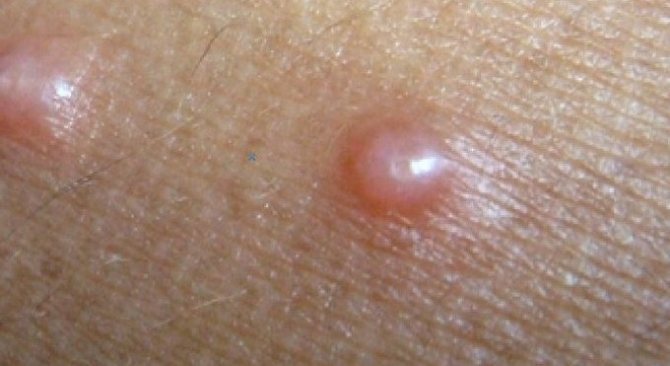
Epidermal cyst filled with fluid
Balls, lumps, nodules, and bulges on the skin are formed due to clogging of sebaceous flows and hair follicles. They often do not cause acute pain and are characterized by slow growth.
Trichilemmal cyst
A small subcutaneous lump that appears on the crown, back of the head, in the temple area near the forehead. It is asymptomatic. It has a smooth surface and a dome shape. It is benign in nature and often recurs. Damages the hair follicle, forming a sac with liquid contents.
Epidermal cyst
It is benign in nature and consists of cells of the upper layers of the epidermis. It is distinguished by its small size (up to 5 cm) and pink tint. It may not go away for a long time.
Lipoma (wen)
Formation consisting of fat cells. It does not cause pain, but when it reaches a large size it can disturb the nerve endings, causing discomfort. Appears as a result of metabolic disorders, diseases of adipose tissue, and is inherited. In rare cases, it becomes malignant.
Atheroma
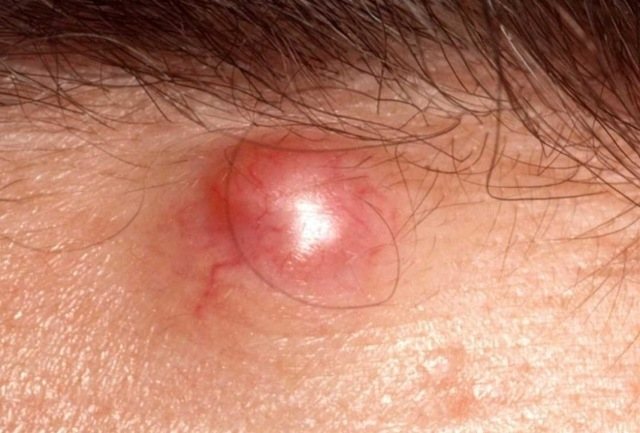
Atheroma is removed surgically
A tumor-like formation localized on the scalp and face. It has clear contours and a mobile watery structure. It can become inflamed, causing fever, swelling, and redness of damaged tissues. Appears due to impaired outflow of the sebaceous glands, increased sweating, and dermatological diseases.
Hemangioma
A benign neoplasm prone to degeneration. Develops due to active proliferation of blood vessels in the scalp. It occurs in childhood in the first months of a child’s life.
Fibroma
A smooth compaction consisting of connective tissues, localized on any part of the body and mucous membranes. It does not cause pain, but can grow to large sizes. It occurs against the background of impaired metabolism, hormonal imbalance, and diabetes.
Inflammatory formations
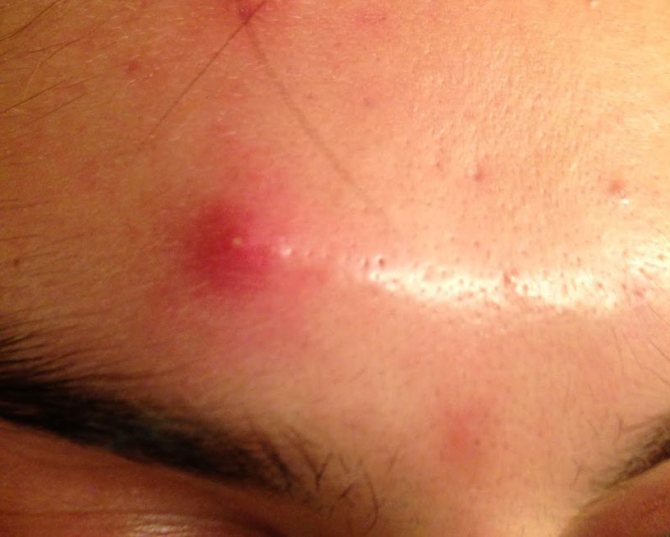
A boil is characterized by an accumulation of pus
If the bump on the forehead did not appear from a blow, when it is injured, infectious processes may develop, accompanied by an increase in temperature, pain, swelling, redness of the skin, and accumulation of pus. Common lumps that occur during inflammation include:
- Boils. Pathological process affecting hair follicles. It begins under the influence of staphylococci due to injuries, scratching, hypothermia, and poor hygiene. The round formation hurts when pressed, swells, turns red, and may have a white core from which purulent exudate mixed with blood oozes. With the frequent appearance of boils, furunculosis develops.
- Seborrheic dermatitis. Inflammation of the skin of a fungal nature with multiple white or yellow scales and numerous bumps. Develops under severe stress, living in an unfavorable ecological place, against the background of a genetic predisposition.
- Inflammation of the lymph nodes. It is observed after suffering from otitis, rubella, furunculosis, mycosis. During palpation, problem areas begin to hurt, become denser, and often appear symmetrically in the area behind the ear of the skull.
If lumps, nodules, or lumps in the forehead area periodically appear and disappear, the nature of their origin can only be determined by a doctor using laboratory or instrumental examination methods.
Why do they appear?
A bump on the head may be the result of a blow.
It usually doesn’t hurt and doesn’t cause much discomfort. However, its appearance is not always so harmless. If the lump is suspicious, very painful, swollen, and even the temperature has risen, and is localized on the back of the head or on the sides of the skull, then it is still worth identifying the cause of its appearance. A lump may appear as a symptom of a neoplasm or other pathology in the body that requires diagnosis and treatment, possibly even surgery. A bump on the head can appear as a result of external trauma: from a bruise or an insect bite, or internal: from a lipoma in the form of a wen, osteoma, furunculosis, kateroma (cyst formation), trichoepithelioma, enlarged lymph nodes.
- Injury. The lump appears on the head in the form of a hematoma with an accumulation of blood under the skin, hurts on palpation, and takes on a lilac or eggplant hue. It is necessary to treat, open surgically, clean the wound from accumulated blood and possibly pus.
- Mosquito, bee or wasp bite. Swelling on the head, burning sensation, pain, itching, and fever may occur. Treatment consists of treating the affected areas, washing with antiseptics, and applying antiallergic ointments (gels). You can't scratch the bump. It is better to immediately go to the emergency room for help, especially if the temperature rises and severe itching overcomes.
- Atheroma in the form of a neoplasm localized on the head due to insufficient outflow of the secretion of the sebaceous glands, their blockage, and the accumulation of a dense consistency under the skin. Requires surgical removal and examination of the material for histology. Usually this is a benign cyst of origin.
- Lipoma in the form of a wen, a benign tumor of dense consistency. Usually the lump does not hurt and does not cause much discomfort. Localizes the forehead and scalp. Appears as a result of metabolic failure and pathology of adipose tissue. It is hereditary in origin and can degenerate into liposarcoma, a malignant neoplasm that requires removal by laser, cryodestruction or surgery.
- Trichoepithelioma is a benign tumor on the head that is usually hereditary. It can be grouped in the form of dome-shaped numerous small elements on the head up to 6 mm in diameter, growing over time, usually not painful on palpation. Treatment involves surgery or electrocoagulation.
- Osteoma in the form of a benign cyst with slow growth, but not capable of degenerating into a malignant form, metastasizing, or growing into nearby tissues. The lump hurts, but sometimes it is not felt at all. Smooth to the touch, slightly raised above the bone tissue in the shape of a ball with smooth edges. The cause of the appearance may be heredity, injury, a number of diseases: gout, rheumatism, syphilis. It must be removed by cutting off nearby healthy areas of bone tissue.
https://www.youtube.com/watch?v=ytdevru
Children, like adults, suffer from the appearance of small tumors on the body. Lumps indicate various diseases. Parents should definitely show their child to a pediatrician to determine the cause of the unpleasant bumps. In addition to the reason for the development of the lump, the age of the baby and the time of initiation of treatment play an important role in the choice of treatment.
Lump on a child's forehead
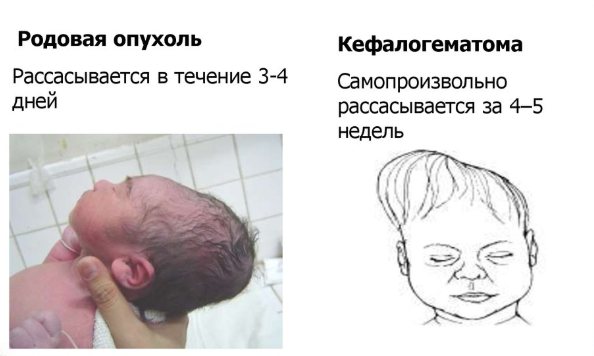
Most often, a bump on the forehead in children appears from a fall, bruise, or injury. The skin of babies is extremely sensitive to any damage, so the tumor grows quickly, increasing in size and changing color. If dangerous symptoms appear - nausea, loss of consciousness, vomiting, drowsiness - it is necessary to urgently hospitalize the victim.
During a difficult birth, infants develop a small formation filled with blood - a cephalohematoma. It appears as a result of a head injury and is removed surgically. This is not dangerous for a newborn.
Osteoma is a hard lump that grows slowly and occurs mainly in boys from 4 years of age. The seal is benign, has a spherical shape and clear boundaries. When pressed it does not hurt and does not move. Occurs due to injuries, congenital syphilis, heredity, rheumatism, gout.
In teenagers, wen often forms on the forehead due to increased sweating, poor hygiene, hormonal imbalance, and active work of the sebaceous glands.
Tumor on the head in the form of a lump: types, why it appeared, symptoms, consequences, treatment
The appearance of a bump on the scalp is not immediately noticed; only when it reaches a fairly decent size does it reveal itself. Tumors differ depending on the type. They can be soft or hard to the touch. The location can be different: on the back of the head, on the forehead, on the temporal part.
Kinds
There are several types of cones:
- Lipoma, its other name is wen. The lump grows quite slowly, there is no pain during palpation, there is a mass in the form of fat inside.
- Papilloma is a benign formation. It can be on a leg or flat. On palpation, as a rule, there is no pain. The surface is loose and can be long or oblong. In older people, warts are often flat, brown, gray or even black.
- Hemangioma is a benign formation that occurs in children immediately from birth. Its surface is red, loose, loose, painless.
- Osteoma is a benign neoplasm that develops from the bone tissue of the skull; accordingly, it is hard to the touch and does not hurt.
- Atheroma is a cyst that begins to grow in place of the sebaceous gland, making it difficult for its secretion to escape. Inside the neoplasm there is sebaceous content, upon palpation pain occurs, and it tends to periodically become inflamed.
- Trichoepithelioma is a benign, small tumor. It develops at the site of the hair follicle. Soft to the touch, painless. The reason for its formation is hereditary predisposition. Multiple formations are often encountered.
- Fibroma is a benign type of tumor that develops from connective tissue and is similar in appearance to a wart. Doesn't hurt when touched.
- Sarcofibroma is a cancerous neoplasm that grows quite quickly from connective tissue, the boundaries are unclear. When palpated, it resembles a knot in the skin covering.
- A furuncle is a purulent formation.
Causes
The reasons are divided into internal and external.
Trauma, bruise
This factor is considered the most common in medical practice. After the blow, swelling occurs in the form of a lump. It is often painful on palpation. A simple bump does not require treatment and goes away on its own; to quickly disappear, you need to apply a cold compress immediately after the blow.
However, if after the blow a person loses consciousness or develops nausea or dizziness, this may indicate a closed head injury. In this case, the brain tissue is directly damaged, and the lump is just an external sign of a dangerous indicator.
If you experience the above symptoms, you should immediately consult a doctor to make sure there is no severe brain damage or bleeding. An MRI or CT scan will be necessary to determine how serious the injury is.
A bite of an insect
Manifests itself as an allergic reaction. The size of the resulting lump can vary from 5 mm to several centimeters, it depends on the severity of the allergy. In this case, anti-allergy medications will help; an examination by an allergist is advisable.
Fibroma (sarcofibroma)
A benign tumor that is hard to the touch. However, in order to make sure that this tumor is really a fibroma and not a malignant formation, it is necessary to undergo tests and seek advice from an oncologist.
The reasons for its occurrence are still not fully understood. Some believe that it can appear in anyone, others believe that it is a hereditary pathology, and others believe that it is due to various skin lesions.
Wart
When large in size, it resembles a lump and is often found on the scalp. Usually, after an examination, a good doctor can accurately indicate the cause of its occurrence, most often it is a sharp decrease in immunity.
Medications can be used for therapy; burning with laser, liquid nitrogen; surgical removal.
Symptoms
Symptoms are determined depending on the type of formation.
Injury
Painful sensations appear when pressed, redness and swelling occur. With more serious injuries, which indicate a closed craniocerebral injury, the following symptoms occur:
- Loss of consciousness occurs immediately after the injury. At this time, the patient does not respond to external stimuli and does not feel pain.
- Pain in different parts of the head - begins immediately after regaining consciousness.
- Nausea and vomiting do not give a feeling of relief.
- Dizziness.
- Hematoma - most often occurs with fractures of the bone frame of the skull. You can often observe the ear and near the eyes.
- The face and neck become red.
- Amnesia - a person does not remember events that happened before the injury (occasionally there are cases when a person forgets events that happened after the injury).
- Development of convulsive syndrome.
- Increased sweating.
If the vessels of the brain are damaged, then hemorrhage in the membranes is possible. This situation is manifested by the following symptoms:
- Sudden pain .
- Photophobia is pain in the eyes in bright light.
- Vomiting and nausea that do not make you feel better.
- Loss of consciousness.
- The muscles of the back of the head are tense, it is impossible to bring the chin to the chest.
Insect bites
With insect bites, sometimes there are no symptoms, but if they are present, immediately after the bite a person may experience itching, swelling, pain, and an increase in temperature. All these symptoms can last up to several days, the pain gradually decreases.
The lump itself is an allergy to insect venom. On palpation, this formation is solid, marked in the center with a red dot, as if pricked by a needle (the site of an insect bite).
Treatment
Treatment for the resulting lumps depends on the type and cause.
First aid for injury is to apply a cold compress to the injury site (frozen foods are often used for this). Keep for about 10 minutes. Preparations in the form of ointments and gels are also used:
- Troxevasin – strengthens vascular walls, relieves swelling. Rub in gently twice a day.
- Troxerutin - effectively eliminates swelling; it is forbidden to apply to injuries where the integrity of the skin is compromised.
- Heparin ointment - relieves pain and resolves blood clots.
- Rescuer - antiseptic effect.
If insect bites occur, treat with soap and cold; if symptoms persist, use anti-allergenic agents. If necessary, consult an allergist or dermatologist.
For lipoma, self-treatment is not carried out; the help of a surgeon is required. Most often it is removed surgically, with a laser, or using a special substance that resolves fat (injected into the wen itself).
For atheroma, the use of various ointments and folk remedies turns out to be ineffective; they are best used for faster healing after removal or self-opening of the tumor. Removal of atheroma is carried out surgically, laser and radio wave methods.
Treatment for fibroids is primarily aimed at eliminating the cause. Next, the tumor is removed using a laser, surgery, cryodestruction (using low temperatures) or radio wave method.
There are several ways to remove a hemangioma:
- Application of liquid nitrogen (no traces are left).
- Microwave cryodestruction – for deep facial tumor localization.
- Radiation therapy – for damage near the eye.
Therapy is carried out exclusively under the supervision of a doctor, since the risk of transformation into a malignant tumor is high.
The boil is removed by a surgeon on an outpatient basis, after which antibacterial and physical therapy is prescribed.
The most effective way to remove a wart is to remove:
- Current therapy is not the most effective method; several sessions are often necessary.
- Freezing with nitrogen is expensive and the surgery leaves visible scars. Long-term postoperative care is also necessary.
- Laser burning is the most widely used procedure and is carried out quickly. No traces remain and similar neoplasms no longer appear.
- Surgical intervention.
Consequences and complications
Whether there will be consequences depends on the extent, type of damage and timeliness of treatment.
Minor bruises usually resolve without complications. Severe ones may in the future affect vision, motor function, mental activity and regular headaches.
Insect bites are complicated by allergic reactions, and with a tick bite, infection with encephalitis and borreliosis is possible.
Boils can provoke meningitis, encephalitis, and cerebral vascular thrombosis. Lipoma can lead to mental and sleep disturbances.
Atheroma provokes the development of infection, which in turn causes relapses, phlegmon - the destruction of the purulent capsule and the spread of pus through the subcutaneous layer and into deeper layers. The most dangerous thing is transformation into a malignant tumor.
Fibroids also carry a risk of cancer. Hemangioma leads to ulcers, blood vessel diseases, external and internal hemorrhages.
In most cases, bumps are not very dangerous, especially painless ones. However, it is always better to consult a doctor to find out the cause and nature of the tumor, thereby eliminating possible complications.
Source: https://nevralgia.ru/opuholi/golovy-v-vide-shishki/
Diagnostic methods
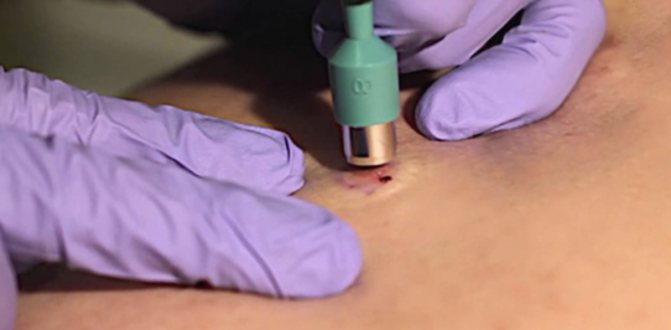
For numerous tumors, a biopsy is performed
After collecting a medical history and examining the problem area, the therapist or dermatologist refers the patient to blood and urine tests, which makes it possible to identify the presence of an inflammatory process in the body. It is also suggested to do:
- tumor marker test;
- X-ray of the skull and ENT organs;
- Ultrasound, MRI of the head.
If numerous lumps appear in the scalp area, a tissue biopsy is performed to identify cancer cells. Treatment measures and further actions depend entirely on the diagnostic results.
Phrenology bumps on the forehead - what do they mean?
In general, phrenology is a science that studies changes and bulges on a person’s head, as a result of which it is possible to predict his fate and tell about his character. Such science has been seen in many countries, but more information can be found in India. In modern times, many criteria have been thought through and changed, taking into account clarification.
A little about the main thing
There are quite a few zone divisions of the head, and they roughly resemble the process of division according to the signs of the zodiac. But at the same time, most often in studying and in concepts one can find such a simple division:
- Frontal part.
- Occipital part.
- Crown.
There are distributions that are made based on the bumps on the forehead, and there is their interpretation. The frontal part does not have a large number of tubercles, but one can judge a lot from them.
It is believed that it is the frontal part that is filled with occult tubercles.
There is such a structure of the skull, when the frontal part of the head is more pronounced, then a lot can be said about such a person, namely that he does not like much communication with people, he is cut off from cosmic communication and influence.
Frontal part
It is believed that if the frontal part stands out and the occipital part is cut off, then such people always strive for independence and successfully achieve it. But at the same time, such a person may not have close protection, which does not always have a positive effect on life.
crown
But a person whose crown stands out strongly has its advantages, since he may have a higher mind, which means he has the opportunity to have dominance over other people.
crown
If there is an increase at the top of the head, then you can hear about justice and truthfulness. It’s easy with such a person, because he will always give what he owes. But if there is no such feature, then it is difficult to equate it to any criterion.
Forehead
If there are bumps on the corners of the forehead, then there are manifestations here - this is a philosophical orientation. The ability to reason and find the right path without offending the inner world of other people. But at the same time, if there is evil, then all manifestations turn out to be the wrong side.
fontanel
The place of the fontanel on the head of any person is the so-called center of separation, when the process of separation of the tubercles occurs. And if this transition is strongly expressed, then a person may exhibit such qualities as stinginess, irresistibility and selfishness.
This is a general concept of tubercles, but in addition to this, you can also find a specific division that talks about this in more detail.
To understand the essence of a person, to determine his destiny, you need to pay attention to natural mounds. Those that were formed as a result of a malfunction of the sebaceous glands cannot tell us anything.
It is the bumps on the frontal part that give insight into a person’s life as a whole. What it will be like, what lies ahead, what you need to be prepared for. Therefore, if bumps or bumps appear on the forehead, this is a sign that there will be some event in life that will significantly affect the fate of its “carrier” and will leave a significant imprint. Let's look at the bumps in detail:
- The bump is large in the middle of the forehead. It portends a serious event that should be expected between the ages of 38 and 60 years. It will change your life completely, turn everything upside down, change your consciousness and worldview. A person with such a bump at a certain moment can begin to build a life from scratch, make new friends, start a family, buy a house, change jobs.
- A medium-sized bump in the center of the forehead. There will be an important event in the life of such a person, but it will not bring specific changes. Perhaps there will be a change in the usual environment, or the view of some thing will become different. But such changes will not bring global changes.
- A small bump in the center of the forehead. It promises a small incident that will make you think about your behavior and life attitudes. This will not change a person's opinion. He will think about it, but will not draw any conclusions; he will continue to think erroneously.
- A large bump almost in the center of the forehead with a slight shift to the left side. It promises a fairly favorable event that you need to wait for from a young age. It is this event that can make the owner’s life many times more successful.
- A medium-sized bump almost in the center of the forehead with a slight shift to the left side. There will be a happy, significant event in a person’s life at a young age, but it will not affect life as a whole.
- A small bump almost in the center of the forehead with a slight shift to the left side. A person with such a tubercle will have enough good events in life that would help him change for the better. But he is unlikely to use them.
- A large bump almost in the center of the forehead with a slight shift to the right side. This phenomenon promises an unfavorable event that should be expected after forty years.
- A medium-sized bump almost in the center of the forehead with a slight shift to the right side. It says that troubles can happen to a person, which can still be resisted, but losses will be incurred. Perhaps small, but large ones are no exception.
- A small bump almost in the center of the forehead with a slight shift to the right side. The owner of such a tubercle will still be able to survive troubles with minimal losses.
- A large bump on the left side of the forehead, hidden under the hair. It says that this person can develop well, unless, of course, he ignores such a chance.
- A large bump on the right side of the forehead, hidden under the hair. A sad event will occur in a person’s life, which will entail the loss of the wealth accumulated over many years.
- A bump above the eyebrow on the left side of the forehead. It may suggest that a person is capable of providing himself with a comfortable old age, but in his youth he will have to go through a number of trials and troubles, and suffer some losses.
- A bump above the eyebrow on the right side of the forehead. Warns that in youth there will be many obstacles and failures. But by gathering all his will into a fist, a person will be able to grow in his professional activity and achieve certain heights.
- Small bumps on the brow ridge on the left side. They promise favorable events. You need to treat them carefully, since they are the ones who will help you realize yourself in life and get on your feet.
- Small bumps on the brow ridge on the right side. They also promise favorable events, but unfortunately, the person will ignore them.
How to remove a bump on your forehead
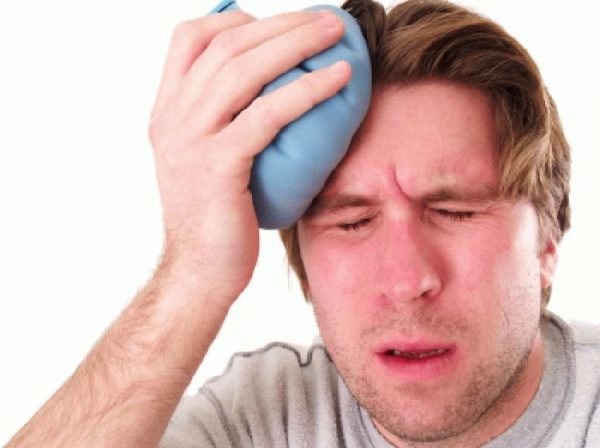
If there is a bruise, apply ice
If a horn has grown on the forehead or in the head area due to a blow (injury), it is necessary to apply cold to the sore spot: wrap a couple of ice cubes in a napkin or clean cloth, but do not apply ice to the skin. Later use absorbable ointment or gel: Troxevasin, Arthrocol, Butadion, Bainvel. This will help reduce the size of the lump, get rid of the bruise and relieve pain. Heat cannot be used.
Benign formations are eliminated with laser or cryotherapy. They are not life-threatening, but can become inflamed if damaged. For lice bites, use lice ointments according to the instructions. If the damage is caused by mosquitoes, gadflies, or bees, take antihistamines and use compresses with Dimexide to relieve swelling.
Purulent processes require antibacterial, anti-inflammatory, and hormonal therapy. The patient takes systemic medications in a dosage calculated by a specialist. If the lymph nodes are enlarged, no special treatment is required. The main thing is not to heat them or rub them. When the immune system gets stronger, the nodes will shrink on their own and will no longer bother the patient.
If the lymph node becomes inflamed and suppuration begins, surgical intervention will be required.
Folk remedies

Fresh tomato juice is applied to boils
At home, you can cope with mild inflammation using folk remedies. Pimples and boils are treated with a tomato mask. Tomatoes contain antioxidants that protect the skin, speed up its recovery, and prevent further tissue infection. Fresh tomato is cut into pieces and applied to the face for 20 minutes. Afterwards wash with warm water. The manipulation is repeated twice a day.
When itchy lumps and pimples appear, lemon juice is effective. Citric acid and vitamin C are beneficial for all types of epidermis. They exfoliate dead skin cells, dry the skin, and have an astringent property. Cut a circle from a fresh fruit and wipe your face with it 2-3 times a day.
Apple cider vinegar is successfully used for cystic formations of the sebaceous glands. Organic acids in the product kill bacteria that cause infection. A cotton swab is soaked in vinegar and applied to the problem area. Secure with a plaster or bandage and leave overnight. Repeat the procedure for 5-7 days. To enhance the effect, you can add a little honey to the vinegar.
If the lump is inflated, and there are no medications nearby, pain and inflammation are relieved by the following means:
- Plantain leaf. The fresh plant is crushed and applied to the diseased area as a compress.
- Potato. The tuber is grated, the resulting pulp is wrapped in gauze and applied to the seal for 30 minutes twice a day.
- Cabbage leaf. Pierce the leaf and knead to release the juice. Apply to the swelling on the forehead until the juice dries. A decoction is also made. The vegetable is boiled in milk, wrapped in a clean cloth and applied to the site of injury or inflammation.
If the bruise does not go away for a long time, ultraviolet irradiation will help. You need to expose your face to the sun, this will contribute to the rapid fading of the hematoma. The procedure should not last longer than 15 minutes.
Treatment of tubercles
For bruises and bites, it is enough to apply a cold compress to the site of the bruise. This can be a cold object or ice, wrapped in cloth before use. The following creams are used to resolve the tubercle: “Rescuer”, “Bodyaga” and “Troxevasin”. They relieve swelling and help the bumps heal faster.
The doctor recommends removing large atheroma, fibroma or hemangioma surgically. After the operation, the patient takes antibiotics. The wound is treated with an antiseptic and sterile dressings are applied. Laser lump removal is becoming popular. This procedure is less traumatic and the wound heals faster.
Copying site materials is possible without prior approval if you install an active indexed link to our site.
The information on the site is provided for general information purposes only. We recommend that you consult your doctor for further advice and treatment.
In many cases, the bumps are not painful and go away on their own, but it is imperative to see a doctor. Formations that arise as a result of an infectious disease are recommended to be treated with antibiotics and antifungal agents. The cysts go away on their own, but if they become inflamed and painful, the therapist prescribes cortisone injections.
Lipomas and cysts require surgical intervention, which create cosmetic discomfort. To remove warts, growths, and papillomas, laser removal, radio-knife removal, and nitrogen burning are used. Lumps that appear after injuries and bruises in children are treated with a cold compress. The faster you apply cold, the less swelling there will be. Then they use creams and ointments to relieve hematomas.
Malignant tumors must be removed. The formation must be removed completely, along with the tissues adjacent to it, in order to prevent relapse. The removed tissue is sent for histological examination.
If the ball under the skin does not become inflamed, enlarged or painful, doctors advise not to touch it.
- purulent cysts;
- inflamed lymph nodes;
- hygroma;
- folliculitis and some other types of formations that can develop into cancer or cause infection to spread throughout the body;
- seals that spoil the patient’s appearance and cause him moral discomfort.
In this case, they will need to be treated, and if conservative methods are ineffective, they will need to be removed.
Classic surgical removal with a scalpel is almost never practiced today. An ultrasonic or laser scalpel is mainly used, especially if women come to remove subcutaneous lumps on the face or open areas of the body.
https://www.youtube.com/watch?v=ytpolicyandsafetyru
There are also absorbable injections. As a rule, these are hormonal drugs, they are injected directly into the seal. Small balls are not always removed; sometimes it is enough to simply pump out their contents and undergo a course of treatment with absorbable drugs that promote tissue regeneration.
Lymphoiditis usually occurs with severe infectious diseases; inflammation must be treated with antibacterial medications; lotions with Dimexide help well. To treat folliculitis, in most cases it is enough to follow the rules of hygiene, adhere to a gentle diet; in severe cases of the disease, external antibacterial and anti-inflammatory agents are prescribed.
Folk remedies can also help cope with the problem. But it should be understood that various lotions, compresses, rubbings based on medicines and other natural products can only eliminate the external manifestations of the disease, but not its cause.
If the lump appears due to a severe infection, hormonal imbalance, varicose veins and other serious pathologies, traditional medicine alone will not solve the problem.
In a cosmetology salon, hardware methods are used to treat problem skin:
- ozone therapy helps saturate the face with oxygen, cleanse clogged pores, relieve swelling and pain, and destroy pathogens;
- Elos technology – light therapy relieves inflammation, tightens pores and accelerates the processes of regeneration and restoration of the integument;
- peeling (fruit acids, dermabrasion, laser therapy) helps to get rid of the layer of dead epidermal cells, facilitating access of oxygen and cosmetics to living tissues.
In addition, during treatment it is necessary to ensure proper body hygiene, treat the affected area with an antiseptic, and avoid decorative cosmetics.
In order for the treatment to be successful and new acne not to appear, it is necessary to provide the skin with additional care:
- wear clothes made from natural fabrics;
- wash your hair separately from your body, because shampoo and conditioner clog pores;
- refrain from visiting the solarium;
- wipe problem areas with products based on salicylic acid.
On the back
After all, it is difficult to make compresses without the help of a loved one.
- In such cases, baths are considered effective. Chamomile infusion and sea salt should be added to hot water.
- Coconut oil dries out rashes well and can be used to lubricate the body and face.
On the body
The skin of the body is rougher and thicker, so getting rid of acne on it is not so easy.
To achieve maximum effect, treatment should include the entire range of measures:
- skin cleansing;
- surface disinfection;
- medicinal baths;
- compresses at night;
- antibacterial ointments;
- proper nutrition.
On the cheek
If a subcutaneous pimple like a lump is detected, a dermatologist will tell you how to get rid of it without risk to health.
- In addition to external remedies against furunculosis, the doctor prescribes brewer's yeast in dry or liquid dosage form. The drug is completely natural and has no contraindications. You need to take it half an hour before meals three times a day for a month.
- To get rid of a pimple on your cheek, you can make a mask or compress from brewer's yeast.
Prevention measures
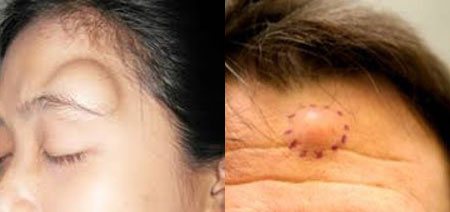
Benign tumors are recommended to be removed while they are small
Even an adult with good coordination of movements cannot completely avoid bumps, bruises and falls. However, you can reduce the likelihood of injury:
- do not leave a small child unattended on the sofa, bed, changing table;
- remove excess rugs and rugs, the edges of which can cause you to trip;
- hold on to the railing when going up/down stairs or steps;
- wear rubberized shoes in the winter season and ice;
- follow traffic rules;
- do not enter into conflict with inappropriate people;
- arrange the furniture in the apartment so that sharp corners do not stick out;
- do not drink alcohol in excessive quantities.
The main danger of nodes, growths, and compactions in the head area is the possibility of degeneration into malignant tumors. If the formation does not go away for a long time, it is better to consult a doctor and not resort to self-medication.
First aid for a forehead bruise
If, in case of a bruise, you immediately provide first aid to the patient, then the next day there will be no trace of the bump.
- Carefully treat the impact site with hydrogen peroxide (or Chlogexidine, Miramistin), especially if, in addition to the bump, there is a bleeding wound.
- Apply a cold object to the sore spot. This could be: a cold towel, a bottle of ice water, a large silver spoon. You can take a piece of frozen meat or fish out of the freezer, but before applying it to your forehead, be sure to wrap it in a clean cloth.
Swollen temples: causes, symptoms, possible problems and doctors' opinions
If your temples systematically swell and your overall health deteriorates, you should seek help from a doctor, since such a phenomenon may indicate that a serious illness is developing.
In this case, self-medication will provoke a deterioration in the patient’s general health.
Only after a thorough medical diagnosis, based on the results of the study, will the doctor prescribe an individual treatment regimen.
Features of temporal arteritis
With temporal arteritis, an inflammatory process develops that affects the arteries of the arms, neck, torso and head. Under such conditions, the temporal arteries are negatively affected. But they provide a complete blood supply to the eyes, optic nerves and head. There are several factors that can cause temples to swell:
- viral;
- genetic;
- ecological.
It is almost impossible to find out the exact cause of the pathology, but most often temporal arteritis is diagnosed in women after 50 years of age. Due to inflammation of the temporal artery, swelling of its wall may occur. Under such conditions, the delivery of oxygen and necessary elements through the bloodstream to the vessels of the head becomes difficult. If a blood clot forms, the person is at high risk of developing a stroke.
Among the main symptoms of this pathological condition are:
- swollen temples;
- painful sensations when pressing on the affected area;
- severe migraine;
- vision problems;
- weakness.
If your temples are swollen and another symptom of the disease appears, it is important to consult a doctor immediately, since the disease can progress and develop into more complex forms.
Therapy process
Treatment should only be prescribed by a specialist. To confirm the diagnosis, the doctor completely examines the patient.
The patient must undergo a complete clinical blood test to determine the erythrocyte sedimentation rate and C-reactive protein.
Based on the identified symptoms of the disease, symptomatic treatment is prescribed, which will help improve the patient’s overall well-being.
If your temples are swollen, your doctor will prescribe medications. The effectiveness of treatment depends on timely contact with a specialist. At the initial stage of disease development, therapy is carried out much faster and more effectively with the help of medications.
During the treatment process, the doctor prescribes anti-inflammatory drugs - glucocorticoids. Such drugs must be taken strictly according to the prescribed regimen. At certain intervals it is necessary to increase the dosage of medications.
After a few days of therapy, the patient’s general well-being will significantly improve, but in order to get a lasting result, drug treatment must be carried out for one and a half to two years.
All this time it is advisable to be under the strict supervision of the attending physician - this will help prevent the development of health problems.
Pain in the temple area can be caused by certain diseases. For example, migraine or increased intracranial pressure often cause an unpleasant symptom.
Why do temples swell? If discomfort occurs in an elderly person, then it is necessary to exclude arterial hypertension and serious pathological changes in the brain. When the body is intoxicated, the patient often feels a feeling of heaviness in the back of the head.
In this case, you should immediately consult a doctor, since self-medication can only cause harm. Most often, pain in the temples occurs when:
- atherosclerosis;
- flu;
- alcohol intoxication;
- infectious sore throat;
- stroke;
- arterial hypertension;
- temporal arteritis;
- migraine and cluster pain;
- neuralgia;
- inflammation of the trigeminal nerve;
- osteochondrosis;
- osteoarthritis;
- hormonal disorders;
- during pregnancy or menopause;
- increased intracranial pressure;
- vegetative-vascular dystonia.
After mental or emotional stress, pain in the temples may occur. Stress, regular lack of sleep, and taking certain medications provoke a deterioration in overall health. To prevent the development of an unpleasant symptom, it is recommended to regularly visit a doctor and not eat smoked foods, fast food and excessively salty foods.
What to do if your temples are swollen and painful?
To improve your overall well-being, you need to seek help from a neurologist. The following activities can help speed up the healing process:
- taking medications;
- performing acupressure;
- use of folk remedies;
- complete rest;
- regulation of diet.
If such recommendations do not help get rid of the unpleasant symptom, then you need to take a medication that will help temporarily eliminate pain in the temples.
What will help?
If the temple and eye are swollen, treatment must be started immediately. The medicine should only be prescribed by a doctor. Tablets can cause the development of health problems if they are not taken as recommended by a doctor.
Thanks to the anti-inflammatory, antispasmodic and analgesic effect, you can eliminate:
- nausea;
- vomiting;
- weakness;
- drowsiness.
The most effective means
If the temples are swollen on both sides, it is recommended to use the following medications:
- Analgin contains metamizole sodium. The drug effectively eliminates the inflammatory process and relieves pain, helps relieve a migraine attack. Among the main advantages of the drug are its affordable price and effectiveness. There are also disadvantages - the drug has a detrimental effect on the liver.
- “Citramon” is one of the most effective blood-thinning and analgesic drugs. The medicine contains caffeine and acetylsalicylic acid. The medication is effective and versatile, but has a number of contraindications for use.
- Ibuprofen effectively eliminates inflammation, relieves pain and relieves fever. Often, specialists prescribe medicine in the treatment of osteochondrosis or vascular inflammation. Among the main advantages of the medicine are its effectiveness and affordable price. Disadvantage – bad effect on the kidneys.
- “Imet” is one of the best non-steroidal anti-inflammatory drugs. Effectively relieves pain, dilates blood vessels and eliminates spasms. Ibuprofen is the main active ingredient. This is a universal drug that will help improve the patient’s well-being in the shortest possible time.
It is not recommended to systematically take medicinal painkillers to improve well-being, since the disease must be cured, and not just masked. Any medications can aggravate the course of the disease if the doctor’s instructions are not followed.
Note to the patient
It is difficult to answer the question of what swollen temples of the head indicate and how to cure this pathological condition. As noted earlier, there are many diseases that can trigger the appearance of an unpleasant symptom.
Only after a thorough medical diagnosis of the patient can a specialist make a diagnosis and prescribe an effective treatment regimen. Based on the laboratory tests obtained, the doctor will prescribe effective medications. Under no circumstances should you self-medicate.
This is a truly serious problem that requires a competent approach and comprehensive treatment.
The duration of treatment and dosage of drugs is determined by the doctor depending on the severity of the unpleasant symptoms and the severity of the disease.
If your temples become swollen when chewing, you should visit a doctor immediately. This symptom often occurs with hypertension. Only after making a diagnosis will a specialist prescribe suitable medications.
Self-medication in some cases can lead to serious health problems.
Source: https://FB.ru/article/453485/opuhli-viski-prichinyi-simptomyi-vozmojnyie-problemyi-i-mneniya-vrachey
